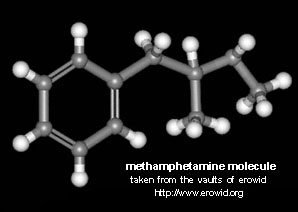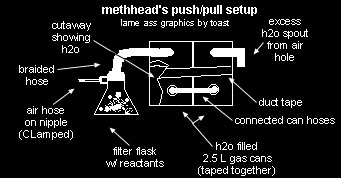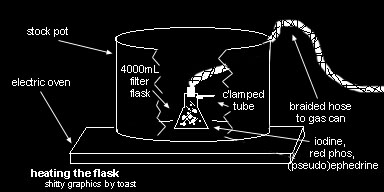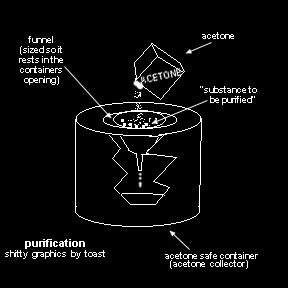
METHHEAD'S PUSH/PULL
SETUP
HTML, and graphics by toast
(Note: the first 4 steps are taken directly from posts by methhead, ignore the direct comments to people)
STEP #1 - Extraction of Pseudoephedrine
|
Materials - Step #1
|
|
gatorade jugss
|
|
pseudo/ephedrine pills
|
|
distilled
H2O
|
|
tube (for siphoning)
|
|
coffee filters
|
|
heat source (for boiling down, electric stove recomended)
|
|
methanol ('Heet' brand works well)
|
....starting with your pills, crush them in a grinder, and put powder into a large washed out gatorade jug. make sure you wash with distilled water only. 1000 60mg pills, will yield 1 ounce of honey, at a 50% return. Next, add distilled water to the powder, and shake....let settle for a minute or two, and siphon off the water. Repeat steps, until you can't taste the pseudo anymore. The pseudo has a bitter taste to it.. Now, make sure that you filter the liquid through coffee filters until the liquid is completely clear. When you have achieved this, boil it down til it's real low and put on medium heat.....continue cooking it down, until your pseudo starts drying out, then finish with a blow dryer... Remember not to burn your pseudo.... Scrape the powder into a small pile, and put into another washed out Gatorade jug. Then add Methanol.... You'll notice that a binder comes out in the methanol, but was clear in the water. Siphon, and filter, til this is clear......I use about 8 bottles of Heet brand methanol for every 4000 pills worth of powder. Again, filter til clear, then put on stove and boil.....this time, use a fan to blow on the top of your glass bowl to make sure it doesn't spill over and catch fire.....Do the same thing that you did with the first batch, low heat, and blow dry.....Now you'll have pure Pseudo.....The reason for the water pull, is to make sure you remove all the wax, because the wax is completely soluble in methanol. I forgot to mention, that when using the water, make sure it is ICE cold. Then, the methanol will bring out the last binder which is soluble in water. Step 2 coming up, but I have to run.
STEP #2 - Preparing the Setup
|
Materials - Step #2
|
|
(2) 2.5L gas cans
|
|
flask, or reaction vessel (perferably filter flask)
|
|
braided hose
|
|
tubing
|
|
PPVC
spout (for excess water)
|
|
one
hole stopper (for flask)
|
|
hose
clamps
|
|
duct
tape
|
|
PVC
connection for one hole stopper
|

..... okay, now you should have your pseudo ready to go......just remember the ratios that I give you..okay...now to make the push/pull......the best thing about it, is the fact that since it's enclosed, there is no smell and the process only takes an hour or so.......take 2 2.5 gallon plastic gas cans....tape them together with duct tape , so that the can sit side by side. Next, take the nozzles from the the gas cans and attach them together.....usually, I cut the end off of one, and stick the other into it. then I hot glue them together, to seal them. so then you attach them back onto the cans. this allows water from one side, to enter into the other side. Make sure that you screw them back on tight, and that your seal is air tight, so that when you stand them up on their ends, water and/or air does not leak out......Next, take the can on the right side and attach a clear pvc tubing onto the air inlet of the gas can. This you use to run into a sink, or shower, or empty container, cuz sometimes iodine water will get pushed out from the reaction. Make sure you use a hose clamp and hot glue to secure it tightly. Next, take the can on the left, and attach a clear, BRAIDED, hose to the air inlet. This is the hose that will be attached to the stopper on the flask. It has to be braided, so that it won't collapse when the heat and pressure build up on the final rxn phase. Make sure that you use a hose clamp, and some hot glue to attach, cuz you don't want it to come loose. once this is down, fill one of the gas with 2 1/4 gallons of distilled water. Then stand the gas cans on end, so that the air inlets are up, and the U connection you made with the spouts are on the bottom. Attaching the hose to the stopper, can be a bit tricky. I use a threaded pvc connector. PVC won't deteriorate from the acids, or the heat. There's a special name for the type of connector I use, so it would be best if I go find out what it is and let you know, cuz the way it's threaded, it won't get pushed out of the stopper. You can build this setup for around 30 american dollars from parts at home depot. I shall return later with the name. Anyways, after you've connected the hose to the stopper, you're almost ready to go. The reason you have distilled water in the cans, is so that you can create a pressure. The push comes from the contents forcing out oxygen, and the pull comes from a complete hydrogen state, and after the final rxn, it tries to "breathe" back in oxygen. Use distilled water, cuz sometimes the pull is so hard, that it actually sucks water, back into the flask. Back soon with step 3.
STEP #3 - The Reaction
|
Materials - Step #3
|
|
heat source (electric stove)
|
|
iodine
|
|
red phosphorous
|
|
pseudo/ephedrine
|
|
distilled
H2O
|
|
duct
tape
|
|
rubbermaid
"server" jug
|
|
visionware
bowl
|
|
fan
(for cooling bowl)
|
|
towel
|

....to answer a couple questions real quick, fzr96.....it shouldn't have cooked for 4 hours......only about 1 to 1 1/2 hours......and if it never pulled, then it was never done........Here, this might help answer the questions...... I use a 4000ml vacuum, or filter flask, cuz it has a nipple on the side. I attach a clear hose to this nipple, with a hose clamp, and pinch the hose closed with a pair of vise grips. Then I'm ready to get started. Here's the ratio..... take whatever amount of E you have, and match it with I. Then divide the amount of E you have, and that's how much R you need to use. My teacher told me though, that if you were to make less than an ounce of honey, you have to use half the amount of R, instead of 1/3. I don't know though, cuz I've never done less than 4 ounces. So, if it's 4 ounces, i should have 240 grams E, 240 grams I, and 80 grams of R. Take the flask, and first dump in the R. Then, dump in the E. Add 3 small capfuls of distilled water. If you're using re-used R, then add a small bump of hydrogen peroxide. Okay, now this part is the best. Add in the I, but be sure to hurry up and stopper the flask. Then use duct tape to wrap around the stopper and neck of flask, to ensure it doesn't pop off on you. Now, pick up the flask and stir the contents. Sometimes it's quick, and sometimes it's not, but the contents inside should start getting liquidy. If it happens quick, the contents will appear to start to grow. Shake more, in order to calm it down, cuz you don't want a fast reaction. You should notice that the water is pushing, and air maybe coming out the right side gas can. Keep stirring and shaking till the entire contents are liquidy. If you look inside the flask, you'll notice tiny little sprinkles everywhere in the mix. This is caused by the I reacting with the R, and creating Hydriodic acid. Keep your eye on it. You'll notice that at first, you have to stir the contents to calm it down. Then after about 15 minutes, it calms down on its own. Then, you have to stir to keep the reaction going. Let this stirring go on for about half an hour or so. Then, get a large stainless steel stock pot, and one of those portable electric stoves. Make sure you use the low burning side.... I went ahead and tested my reaction heat by getting a candy thermometer, and placing the stock pot on the stove and turning it on, I've noticed that you don't ever want your heat to get higher than 180 degrees, and that you should start cooking at 150 degrees... Test your stove out before you cook, and look at the dial on the stove, as to where the certain degrees are. Now, place the stock pot on the stove, at 150 degrees, and place the flask in the pot. Pick up the flask every few minutes and keep stirring, replacing the flask back in the pot. After about half an hour of this, (making it 1 hour total cook time), turn up the heat to 180 degrees and keep the stirring process up. You'll notice that the contents will get real liquidy, and a yellow film will be inside. The mix will look like it wants to literally grow inside the flask. After a few more shakes, let it go, you'll notice that more air and water will get pushed out of the gas can and the reaction will get violent. At this stage, I usually throw a towel over the top of the flask, cuz I've had accidents before, like the hose coming out of the stopper and contents get sprayed everywhere. When the push/pull is a rockin away, then unplug the stove and let it go. When the pushing has stopped, check the flask. The contents should have grown, and filled the entire flask, and a swirling green/white smoke should fill the flask. If this didn't happen, then it's not done. Plug back in the stove, and let it go. This final reaction, is what turns your E into Honey. What happens, is the contents reach a totally hydrogen state. The last of the I has turned into Hydriodic acid and all the oxygen gets pushed out of the flask. This is where you get the pull from...Cuz the hydrogen state combined with heat, creates a pressurized vacuum state. After this final reaction has happened, let the flask cool down, and every 2 minutes, stir the contents. You do this, because when you stir up the contents, you make sure that more E gets turned into Honey. Then when the flask has cooled down to a warm state, keep the nipple hose pinched, and release the vice grips. Place a funnel into the hose, and add distilled water to the funnel, then unpinch the hose and let the water into the flask. Let air get in through the hose cuz if you don't, then as soon as the water hits the inside of the flask, the vacuum will pick up and suck water from the push/ pull. Add more distilled water and remove the duct tape and stopper. Shake the flask around, and pour the contents into a heavy visionware bowl. Add more distilled water to the flask, to clean it out, and add to the visionware. Next, place bowl on the stove, and put on high heat. Get a plastic spoon, and wash with distilled water, to use to stir the mix. Place a fan next to the stove to use to cool the bowl down. Stir the contents to a boil, and remove from heat. Turn the fan on, onto the bowl, and let cool down a bit. You'll notice that all of your R has dropped to the bottom of the bowl, and it's ready to filter. You should have a golden colored liquid. Filter, until all the R is out of the liquid, and place into a rubbermaid "server" jug. I'll be back with the rest in a bit........THE FINAL STEPS
STEP #4 - THE FINAL STEPS
|
Materials - Step #4
|
|
store bought ice
|
|
coleman's fuel
|
|
'red
devil' brand lye (sodium hydroxide)
|
|
gatorade bottles
|
|
distilled
H2O
|
|
tube
(for siphoning)
|
|
towel
|
|
shot
glass
|
|
'3-way
pool test strip' (pH paper)
|
|
muriatic
acid
|
|
eye
dropper type bottle
|
|
visionware
bowl
|
|
heat
source
|
|
fan
|
|
blow
dryer
|
|
ice
water
|
FINAL STEPS>>>>>>>okay boys and ghouls, yes, this is the most important part, and if you follow everything right, you won't even need to wash the shit......trust me, my honey has never needed a washing YET!.....almost never leaves a residue in the pipe.....trust me... where i live.....i'm just about number one in quality......and i'll be chatting to TOAST about pics.............okay........ put the yellow colored liquid into the rubbermaid server jug from wal-mart..... this is acid/honey water.......put in a small layer of ice (bag of ice bought from any store, cuz it's allllll distilled), then add an equal portion of Colemans fuel..... if you don't use ice, you're going to get a volcano eruption of lye/acid/colemans all over the place.......when the lye hits the acid, it'll heat up and create alot of pressure......the ice keeps this from happening, until you shake up the container.. next, add about 1/4 can of Red Devil Lye... in mine, it takes about a 1/2 can...... but you don't want to overkill the lye or you'll lose everything.......now screw on the pop-top lid, and shake, with small towel over the top....just in case of leakage.... the jug should heat up and expand.....let settle for a second, and undo the pop-top to let out pressure, close, and repeat...... add more lye as you go along, until you get a very strong cat urine/ammonia smell..... when your nostrils have received this little message, it's time to let the mix settle, and siphon........take a large gatorade bottle, and poke a hole in the screw top.... next, wash out the bottle, and cap thoroughly, using distilled water........ next, siphon the colemans, into a filtered funnel, into the gatorade bottle.......now, you should have one gatorade bottle, with honey/colemans fuel in it........add an equal amount of distilled water to this.... then, shake the contents up..always remember to cover the hole in the top with your finger when shaking.......turn the bottle over, holding the hole closed, and let settle, then with your other hand, grab a 3-way pool test strip and place over a shot glass, then let a small amount of water run over the ph part of the strip....the color should be a violet blue........lots of honey in there folks......so, turn the jug upright again, and remove cap......next, we have to "push" the honey into the water.... to do this, get some muriatic acid, and a small bottle with a dropper type top on it. fill this with muriatic, and add a small squirt into the bottle.......if you look at the water when you do this, you'll see the acid fall to the bottom, and quickly surface. But, with the acid, you'll see ribbons of honey stay in the water........cover the hole with your finger again, and shake..... turn the bottle over, holding the hole with your finger, and test again.....keep repeating this, until the ph strip turns a reddish-pink color......this is the ph level you need to keep it at.....if the strip goes yellow, that means there's too much acid and there's nothing you can do about it... at least not if you haven't saved anything in your shot glass......just take the water from the shot glass, and add it to the jug, then retest.......if the strip is okay, then replace a clean visionware bowl on the stove, and drain the water into it.....bee careful not to let the colemans fuel fall into it, or your honey will be good, but tainted......if some does get through, take lighter, and light the top of the water, and the colemans will burn away........ now, turn it up to a boil, and wait till you see it "cracking back". you should have the fan on it, to help it go faster. When it starts to "crack back" alot, remove from heat, and place the bowl in ice water.... WARNING.....make sure its a Corning VisionsWare bowl....it's the only glass bowl that I know of that can go from extreme heat and cold......other glass bowls would shatter upon even touching the ice cold water..... after putting the bowl in ice water, make sure you get a blow dryer, and blow air into the bowl to help it dry......if it's still too liquidy after 5 minutes, then replace on the heat for a few more minutes and repeat.. if you're too afraid of hurting the honey, then just use the blow dryer to dry the rest of the way..........well folks, all I can do to help you, is answer questions, take some pictures, and MAKE THE VIDEO..... wonder if I should charge?....doubt it..... knowledge is free.......
STEP #5 - Purification
OD #1
Washing is not necessarily a needed step, and is provided just a misc. information.
By toast, Inspired by Replies from Wehh, spitball (this whole thing is pretty much his idea in my words), and Worlock
|
Materials - Step #5 - Method #1
|
|
acetone
|
|
funnel
|
|
acetone safe container
|

Find a container that is made of an acetone safe material (glass, some plastics), this will be your "used acetone collector". Now find a funnel as big as the opening of this container. Place the funnel so it rests in the opening, and place a coffee filter or two in the top of the funnel. On this filter, place your "substance to be purified." The acetone for this procedure should be pre-chilled, just put it in the freezer for awhile. Putting it in the freezer for too long could cause condensation (thanks spitball). Pour the cold acetone over the "substance to be purified" and watch as it gets whiter and whiter! :0) (Note: "If you're not using lab grade acetone, you're going to lose more of the product any ways, so there's really no reason to cool it, although in small quantities it'll be a noticable loss." - spitball)
OD #2
Image by toast, taken from "The Organic Chemistry Survival Manual" by James W. Zubrick, pg. 128
|
Materials - Step #5 - Method #2
|
|
acetone
|
|
buchner funnel
|
|
filter paper (coffee filter)
|
|
vacuum
source
|
|
tubing
|
|
filter
flask
|
|
one
hole stopper
|

I feel much explanation for this method is not needed, seeing as how purification may not even be a necessary step in the push/pull method (see Step #4). However, it must be clarified that the "substance to be purified" is mixed with acetone in a seperate flask, then poured through the funnel, with the vacuum on. The vacuum removes the acetone and the impurities, with minimal loss of product (thanks Worlock).
last updated: 6/13/99